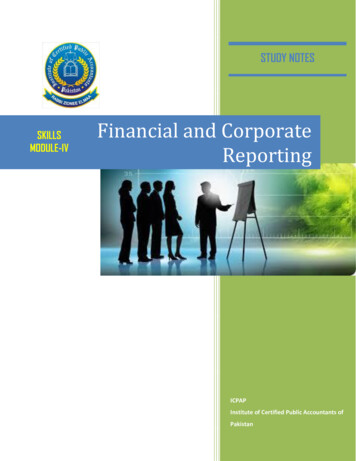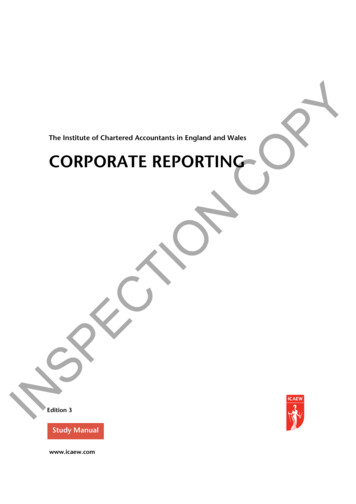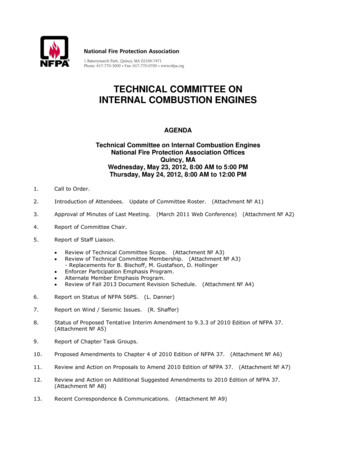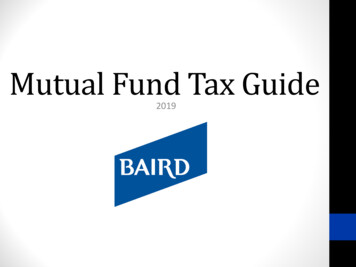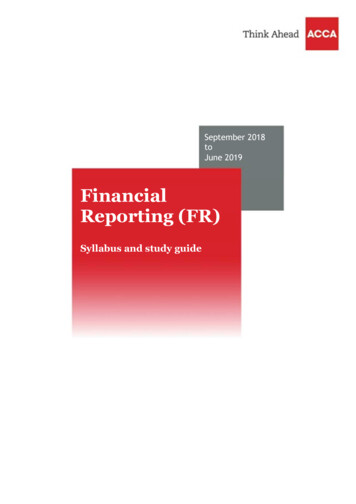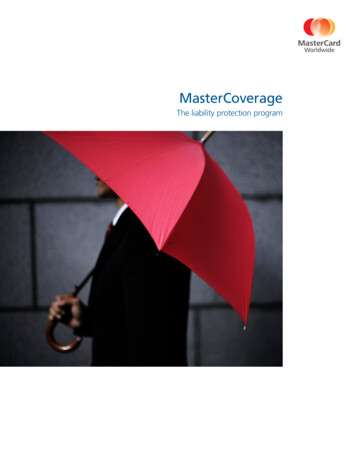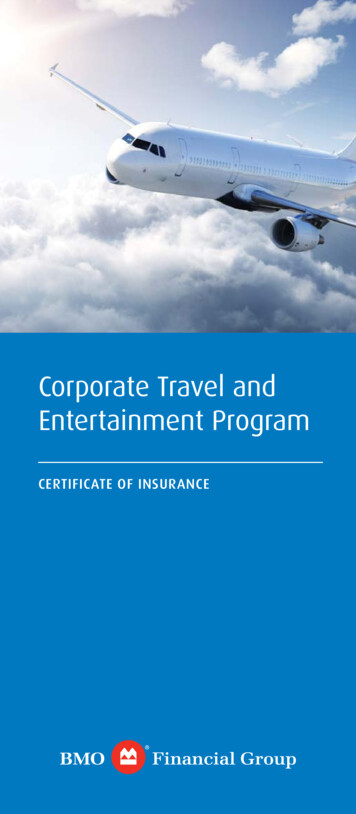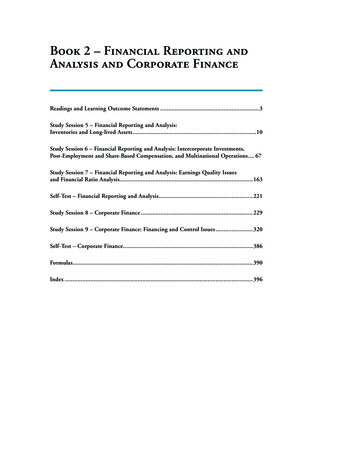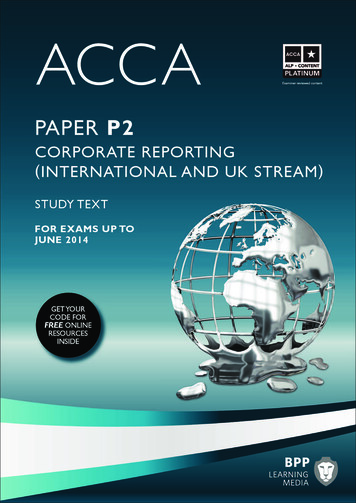
Transcription
Maximise Your Exam Success with BPP Learning Media’sPlatinum Approved MaterialsLEARNOur Study Texts are the only Texts that have been reviewed by the examiner. This ensures that our coverage of thesyllabus is appropriate for your exam. By choosing our Platinum Approved Study Text you are one step nearer toachieving the exam success you deserve.PRACTISE AND APPLYOur Practice & Revision Kits are the only Kits that have been reviewed by the examiner. Use our Kits and our i-PassCD-ROMs to reinforce and apply your knowledge. Kits are packed with past ACCA exam questions together withfull solutions and handy tutor’s hints.i-Pass contains approximately 300 questions, covering all important syllabus areas.REVISE AND RETAINRevise using our pocket-sized Passcards and then listen to our audio Success CD to give your revision a boost.Our Interactive Passcards product takes the Passcards, adds additional tutorials, comments and lots of testing and linksthem to the Study Text. The result is a truly interactive revision experience. Revise using the on-screen Passcards anddip into the on-screen Study Text for more detail.BPP LEARNING MEDIA CUSTOMER SERVICESTel: 0845 075 1100 (UK)Email:learningmedia@bpp.comTel: 44 (0)20 8740 2211 (Overseas)Website: www.bpp.com/learningmediaTo help maximise your chances of passing, we’ve put togethersome exclusive additional ACCA resources. To access the BPPACCA online additional resources for this material please go to:http://accaresources.bpp.com/studentn Create a user account if you don’t already have one.Make sure you reply to the confirmation email.n Log in using your registered username and password.Select the paper you wish to access.n Enter the code below when prompted. You will only haveto do this once for each paper you are studying.
STUDYPAPER P2CORPORATE REPORTING(INTERNATIONAL ANDUNITED KINGDOM)BPP Learning Media is the sole ACCA Platinum Approved Learning Partner – contentfor the ACCA qualification. In this, the only Paper P2 study text to be reviewed by theexaminer: We discuss the best strategies for studying for ACCA exams We highlight the most important elements in the syllabus and the key skills you will need We signpost how each chapter links to the syllabus and the study guide We provide lots of exam focus points demonstrating what the examiner will want you to do We emphasise key points in regular fast forward summaries We test your knowledge of what you've studied in quick quizzes We examine your understanding in our exam question bank We reference all the important topics in our full indexBPP's Practice & Revision Kit, i-Pass and Interactive Passcard products alsosupports this paper.FOR EXAMS UP TO JUNE 2014TEXT
First edition 2007Sixth edition October 2012ISBN 9781 4453 9654 5(Previous ISBN 9781 4453 7768 1)e-ISBN 9781 4453 9214 1British Library Cataloguing-in-Publication DataA catalogue record for this bookis available from the British LibraryAll rights reserved. No part of this publication may bereproduced, stored in a retrieval system or transmitted, inany form or by any means, electronic, mechanical,photocopying, recording or otherwise, without the priorwritten permission of BPP Learning Media Ltd.We are grateful to the Association of Chartered CertifiedAccountants for permission to reproduce pastexamination questions. The suggested solutions in theexam answer bank have been prepared by BPP LearningMedia Ltd, unless otherwise stated.Published byBPP Learning Media LtdBPP House, Aldine Place142-144 Uxbridge RoadLondon W12 8AAwww.bpp.com/learningmediaPrinted in the United Kingdom byPolestar WheatonsHennock RoadMarsh BartonExeterEX2 8RPYour learning materials, published by BPP LearningMedia Ltd, are printed on paper sourced fromtraceable, sustainable sources. BPP Learning Media Ltd2012ii
ContentsPageIntroductionHelping you to pass – the ONLY P2 Study Text reviewed by the examiner!Studying P2Important note for UK studentsThe exam papervviiviixxxivPart A Regulatory and ethical framework123Financial reporting frameworkProfessional and ethical duty of the accountantEnvironmental and social reporting32555Part B Accounting standards4567891011Non-current assetsEmployee benefitsIncome taxesFinancial instrumentsShare-based paymentProvisions, contingencies and events after the reporting periodRelated partiesLeases81125149175227241255263Part C Group financial statements121314151617Revision of basic groupsComplex groups and joint arrangementsChanges in group structuresContinuing and discontinued interestsForeign currency transactions and entitiesGroup statements of cash flows283327353385393413Part D Performance reporting18192021Performance reportingCurrent developmentsReporting for specialised entitiesReporting for small and medium-sized entitiesExam question and answer bankMathematical tablesIndexReview form437495511529539627631Contentsiii
A note about copyrightDear CustomerWhat does the little mean and why does it matter?Your market-leading BPP books, course materials and e-learning materials do not write and updatethemselves. People write them: on their own behalf or as employees of an organisation that invests in thisactivity. Copyright law protects their livelihoods. It does so by creating rights over the use of the content.Breach of copyright is a form of theft – as well as being a criminal offence in some jurisdictions, it ispotentially a serious breach of professional ethics.With current technology, things might seem a bit hazy but, basically, without the express permission ofBPP Learning Media: Photocopying our materials is a breach of copyright Scanning, ripcasting or conversion of our digital materials into different file formats, uploadingthem to facebook or emailing them to your friends is a breach of copyrightYou can, of course, sell your books, in the form in which you have bought them – once you have finishedwith them. (Is this fair to your fellow students? We update for a reason.) Please note the e-products aresold on a single user licence basis: we do not supply ‘unlock’ codes to people who have bought themsecond-hand.And what about outside the UK? BPP Learning Media strives to make our materials available at pricesstudents can afford by local printing arrangements, pricing policies and partnerships which are clearlylisted on our website. A tiny minority ignore this and indulge in criminal activity by illegally photocopyingour material or supporting organisations that do. If they act illegally and unethically in one area, can youreally trust them?iv
Helping you to pass – the ONLY P2 Study Text reviewedby the examiner!BPP Learning Media – the sole PlatinumApproved Learning Partner - contentAs ACCA’s sole Platinum Approved Learning Partner – content, BPP Learning Media gives you theunique opportunity to use examiner-reviewed study materials for the 2013 and June 2014 exams. Byincorporating the examiner’s comments and suggestions regarding the depth and breadth of syllabuscoverage, the BPP Learning Media Study Text provides excellent, ACCA-approved support for yourstudies.The PER alertBefore you can qualify as an ACCA member, you do not only have to pass all your exams but also fulfil athree year practical experience requirement (PER). To help you to recognise areas of the syllabus thatyou might be able to apply in the workplace to achieve different performance objectives, we haveintroduced the ‘PER alert’ feature. You will find this feature throughout the Study Text to remind you thatwhat you are learning to pass your ACCA exams is equally useful to the fulfilment of the PERrequirement.Your achievement of the PER should now be recorded in your on-line My Experience record.Tackling studyingStudying can be a daunting prospect, particularly when you have lots of other commitments. Thedifferent features of the text, the purposes of which are explained fully on the Chapter features page, willhelp you whilst studying and improve your chances of exam success.Developing exam awarenessOur Texts are completely focused on helping you pass your exam.Our advice on Studying P2 outlines the content of the paper, the necessary skills the examiner expectsyou to demonstrate and any brought forward knowledge you are expected to have.Exam focus points are included within the chapters to highlight when and how specific topics wereexamined, or how they might be examined in the future.Using the Syllabus and Study GuideYou can find the syllabus and Study Guide on page ix to xxxiii of this Study Text.Testing what you can doTesting yourself helps you develop the skills you need to pass the exam and also confirms that you canrecall what you have learnt.We include Questions – lots of them – both within chapters and in the Exam Question Bank, as well asQuick Quizzes at the end of each chapter to test your knowledge of the chapter content.Introductionv
Chapter featuresEach chapter contains a number of helpful features to guide you through each topic.Topic listTopic listSyllabus referenceWhat you will be studying in this chapter and the relevantsection numbers, together the ACCA syllabus references.IntroductionPuts the chapter content in the context of the syllabus asa whole.Study GuideLinks the chapter content with ACCA guidance.Exam GuideHighlights how examinable the chapter content is likely tobe and the ways in which it could be examined.Knowledge brought forward from earlier studiesWhat you are assumed to know from previousstudies/exams.FAST FORWARDSummarises the content of main chapter headings,allowing you to preview and review each section easily.ExamplesDemonstrate how to apply key knowledge andtechniques.Key termsDefinitions of important concepts that can often earn youeasy marks in exams.Exam focus pointsWhen and how specific topics were examined, or howthey may be examined in the future.Formula to learnFormulae that are not given in the exam but which have tobe learnt.Gives you a useful indication of syllabus areas thatclosely relate to performance objectives in your PracticalExperience Requirement (PER).viIntroductionQuestionGives you essential practice of techniques covered in thechapter.Case StudyReal world examples of theories and techniques.Chapter RoundupA full list of the Fast Forwards included in the chapter,providing an easy source of review.Quick QuizA quick test of your knowledge of the main topics in thechapter.Exam Question BankFound at the back of the Study Text with morecomprehensive chapter questions. Cross referenced foreasy navigation.
Studying P2Paper P2 Corporate Reporting is a tough paper, reflecting the demands that will be made upon theprofessional accountant in his or her working life. At the Fundamentals level, you will have studied theessentials of financial statement preparation and analysis, including those of group accounts. At theProfessional level, these essentials will be assumed knowledge. You will be required to apply them,assuming the role of a professional adviser and analyst to the management as well as the shareholdersand other stakeholders.What is the paper about?The P2 syllabus comprises eight main areas:ABCDEFGHThe professional and ethical duty of the accountantThe financial reporting frameworkReporting the financial performance of entitiesFinancial statements of groups of entitiesSpecialised entitiesImplications of changes in accounting regulation on financial reportingThe appraisal of financial performance and position of entitiesCurrent developmentsThere is, of course, some overlap between these areas. For example, if you are discussing currentdevelopments (H), you might be talking about the proposed changes to accounting for businesscombinations (D) and considering the implications of changes in accounting regulation (F) and perhapseven the ethical duty of the accountant to report those changes fairly and accurately (A).What skills must you demonstrate?At the Fundamentals level, the questions would be more easily categorised into syllabus areas. However,at this level you may need to demonstrate knowledge, skills and thinking from outside the syllabus areathat the question seems to be about on the surface. The examiner has stated:Students should be capable of relating professional issues to relevant concepts and practicalsituations. The evaluation of alternative accounting practices and the identification andprioritisation of issues will be a key element of the paper. Professional and ethical judgement willneed to be exercised, together with the integration of technical knowledge when addressingcorporate reporting issues in a business context.So the paper is not predictable. That said, clear guidance has been given. The compulsory Section Aquestion, worth 50 marks, will always be on group accounts. It will also deal with issues in financialreporting and will be case study based. In Section B, questions could be on any area of the syllabus, butwe have been told that two questions will be scenario based and one question will be an essay. You have achoice of two from three.Increasingly, questions are discursive rather than numerical, so it is vital that you get practice atanswering this type of question.Important note for UK studentsIf you are sitting the UK P2 paper you will be studying under International standards and up to 20 markswill be for comparisons between International and UK standards.This Text covers all the topics you need to know under International standards and we have produced asupplement covering the additional UK issues.Introductionvii
Exam technique for P2Do not be needlessly intimidatedThere is no shortcut to passing this exam. It looks very difficult indeed, and many students wonder if theywill ever pass. But many do. How do they do this?Easy marksAll the questions are demanding, but there are many easy marks to be gained. Suppose, for example, youhad a consolidated statement of cash flows with a disposal, some foreign exchange complications and animpairment calculation. There will be easy marks available simply for the basic cash flow aspects, settingout the proforma, setting up your workings, presenting your work neatly. If you recognise, as you should,that the disposal needs to be taken into account, of course you will get marks for that, even if you make amistake in the arithmetic. If you get the foreign exchange right, so much the better, but you could pass thequestion comfortably omitting this altogether. If you’re short of time, this is what you should do.Be ruthless in ignoring the complicationsLook at the question. Within reason, if there are complications – often only worth a few marks – that youknow you will not have time or knowledge to do, cross them out. It will make you feel better. Than tacklethe bits you can do. This is how people pass a seemingly impossible paper.Answer all questions and all parts of questionsThe examiner frequently comments that students don't do this, so they miss easy opportunities to gainmarks.Be ruthless in allocating your timeAt BPP, we have seen how very intelligent students do one almost perfect question, one averagely goodand one sketchy. For a fifty mark question, the first twenty marks are the easiest to get. Then you have topush it up to what you think is thirty to get yourself a clear pass. For a twenty-five mark question, the firsteight to ten marks are the easiest to get, and then you must try to push it up to fifteen.Do your best question either first or second, and the compulsory question either first or second. Thecompulsory question, being on groups, will always have some easy marks available for consolidationtechniques.viiiIntroduction
InternationalIntroductionix
xIntroduction
Introductionxi
xiiIntroduction
Introductionxiii
xivIntroduction
Introductionxv
xviIntroduction
Introductionxvii
xviiiIntroduction
Introductionxix
xxIntroduction
United KingdomIntroductionxxi
xxiiIntroduction
Introductionxxiii
xxivIntroduction
Introductionxxv
xxviIntroduction
Introductionxxvii
xxviiiIntroduction
Introductionxxix
xxxIntroduction
Introductionxxxi
xxxiiIntroduction
Introductionxxxiii
The exam paperThe paper will comprise two sections.Section A:Section B:1 compulsory case studyChoice of 2 from 3 questions (25 marks each)Number of marks5050100Section A will be a scenario-based question which will include: The preparation of consolidated financial statements (including consolidated statements of cash flows)with adjustments on other syllabus areas A written part normally covering a particular accounting treatment and ethical and social issues infinancial reporting.Section B will normally include: Two scenario or case study-based questions (covering a range of standards and syllabus topics, oneusually in the context of a particular industry) A essay-style discussion question, often encompassing current developments in corporate reporting,which may also include some short calculations.Analysis of past papers – by sittingJune 2012Section A1Consolidated statement of financial position with business combination achieved in stages and jointoperation; de-recognition of financial asset; ethicsSection B234Sale and leaseback, defined benefit pension plan, cash-settled share-based payment and contingentliability in the context of a business combinationMeasuring fair value, impairment of goodwill, deferred tax liabilities and the fair value option for anaccounting mismatch; shares as financial liability or equityChanging rules on provisions (discussion and calculation)December 2011Section A1Consolidated statement of financial position with business combination achieved in stages; segmentreporting; ethicsSection B234xxxivIntroductionInternal reconstructionIntangible assets and impairment testing rulesRevenue recognition: principles and application
June 2011Section A1Groups with a foreign subsidiary, other adjustments and the remainder on ethical issuesSection B234Specialised industry question with IFRS 1, IFRS 3 intangible assets and restructuring plans andprovisionsSpecialised industry question with reclassification of long-term debt, correction of an error, revenuerecognition, related party disclosures and classification of a employee benefit planChange to IFRS 9 rules for financial assets; change to expected loss model for impairment offinancial assetsDecember 2010Section A1Consolidated statement of cash flows; ethics of changing methodSection B234Share-based payment; derivativesProvisions, contingent liability, significant influence; share-based paymentSmall and medium-sized entitiesJune 2010Section A1Groups with complex group and two disposals and the remainder on ethical issuesSection B234A range of topics including deferred tax, impairments, a deemed disposal/discontinuation andretirement benefitsSpecialised industry with derivatives, hedge accounting, brands and the purchase of retail outletsthrough companiesFlaws in lease accounting; application of Framework, sale and leasebackDecember 2009Section A1Consolidated statement of financial position with changes in group structureSection B234Impairment: discussion and calculationRevenue recognition; recognition of assets; joint controlComplexity in financial instrumentsJune 2009Section A1Business combination achieved in stages; ethicsSection B234Financial instruments: fair value, convertible bonds, derecognition, foreign subsidiary’s debt, intereston employee loanRevenue recognition, assetsEmployee benefits: problems of current treatmentsIntroductionxxxv
December 2008Section A1Group statement of cash flows with adjustments and interpretation; ethicsSection B234Changes to accounting for business combinationsTangibles, intangibles and revenue recognitionAccounting standards and disclosureJune 2008Section A1Groups with a foreign subsidiary, other adjustments and the remainder on ethical issuesSection B234Segment reporting and revenue recognition in a specialised industryRetirement benefits and financial instrumentsTransition to IFRSDecember 2007Section A1Piecemeal acquisition; factored receivables; environmental provision and report; ethical and socialattitudesSection B234Employee benefits; provisionsDiscontinued operations; deferred tax; impairment; leaseConceptual FrameworkPilot paperSection A1Statement of cash flows; criteria for consolidation; ethical behaviourSection B234xxxviIntroductionEnvironmental provision; leasing; EARP; share-based paymentDeferred tax with pension scheme and financial instrumentsAdoption of IFRS; proposals on business combinations
Analysis of past papers – by syllabus topicThe table below provides details of when each element of the syllabus has been examined and thequestion number and section in which each element appeared. Further details can be found in the ExamFocus Points in the relevant chapters.Coveredin ne2012Q1(b)Q1(b)Q1(c)Q1(c)3(b)Q4Q2(c)Q1(a)THE PROFESSIONAL AND ETHICAL DUTYOF THE ACCOUNTANT3Professional behaviour and compliancewith accounting standardsEthical requirements of corporate reportingand the consequences of unethicalbehaviourQ1(c)33Social responsibilityQ1(c)Q1(c)Q1(c)Q1(c)Q3Q1 (a)Q2, Q3Q1(a)Q1(a)Q3Q1(a)Q1(a),THE FINANCIAL REPORTING FRAMEWORK1The contribution and limitations of financialstatements in meeting users' and capitalmarkets' needs1The applications, strengths and weaknessesof an accounting framework1Q4(c)Critical evaluation of principles andpractices–Revenue recognition–Substance over form issuesQ2(b)Q3Q3REPORTING THE FINANCIALPERFORMANCE OF ENTITIES18Performance reportingNon-current assets4–Property, plant and equipment–Intangible assets–Impairment–Investment properties–Government grants–Borrowing costs7Financial instruments11Leases18Segment reporting5Employee benefits6Income taxesQ3Q3Q2,Q3Q1(a),Q3(c)Q1(b)Q1(a),Q33(c)Q3Q1(a), Q3Q2, Q3(d)Q1(a),Q2Q1,2(a)Q3Q3Q1(b),Q3, Q4Q1(a), Q1(a), Q2,(b) 2Q1(a)Q1(a)Q2Q1(a)–Provisions, contingency liabilities andcontingent assets–Events after the reporting period10Related parties8Share-based payment11LeasesQ3(d)Q1(a),Q2(b)Q3Q1(a),Q2Q1, ions, contingencies and events afterthe reporting period9Q1(a), Q3 Q1(a), Q3Q4Q3(c)Q2, Q3Q2Q4Introductionxxxvii
Coveredin NCIAL STATEMENTS OF GROUPS OFENTITIESQ3(c)Group accounting including statements ofcash flow12, 13,1713–Complex groups–Associates–Joint venturesQ1(a),Q2Q3–Group statements of cash flowsQ1(a)Q1Q1(a)Q3Q1(a)Q1(a)Continuing and discontinued interests–Discontinued operations–Non-current assets held for saleQ2Q3(a)Q2Changes in group structure14–Mid year acquisitions–Disposals–Business combinations achieved instages–Group reorganisationsQ2Q1(a)Q2Q1(a),(b)Q1(a),(b)Q 1(b)Q1(a),Q2Q1(a)Q1(a)Q2Foreign transactions and entities16–Foreign currency transactions–Foreign )Q1(a),(b)SPECIALISED ENTITIES20Financial reporting in specialised, not-forprofit and public sector entitiesQ2Q3Q3Q2, Q3IMPLICATIONS OF CHANGES INACCOUNTING REGULATION ONFINANCIAL REPORTING21The effect of changes in accountingstandards on accounting systems12Proposed changes to accounting standardsQ4(a)Q2(a),(b)THE APPRAISAL OF FINANCIALPERFORMANCE AND POSITION ENTITIES18The creation of suitable accounting policies18Analysis and interpretation of financialinformation and measurement ofperformanceQ2(b),Q3Q1(b)CURRENT DEVELOPMENTS3, 19Environmental and social reportingQ1(b)19Convergence between national andinternational reporting standardsQ4(a)19Comparison of national reportingrequirementsQ4(b)Current reporting issues1, 6, 19xxxviii–Conceptual Framework–Fair value measurement–Management commentary–Pensions–Revenue recognitionIntroductionQ4Q1(a)Q4Q1(a)
PARTARegulatory and ethicalframework1
2
Financial reportingframeworkTopic listSyllabus reference1 International Financial Reporting Standards (IFRSs)A12 Corporate governanceC13 Conceptual frameworkB24 Revenue recognitionA2, B1IntroductionWelcome to the Corporate Reporting paper using International FinancialReporting Standards (IFRS). This paper is about thinking and applying yourknowledge of the IFRS. Most of the standards and topics have been covered inyour earlier studies. However, at the Professional level, you need to thinkcritically about them and show an understanding of topical issues. In the exam,you will need to put yourself in the role of an adviser to a business entity, usingyour knowledge to give practical advice.In the exam, you will often be required to consider the impact of proposedchanges to IFRS. Any such proposals are dealt with in this Study Text withinthe topic to which they relate.3
Study guideIntellectual levelA1Professional behaviour and compliance with accounting standards(a)B1Appraise the ethical and professional issues in advising on corporatereportingAssess the relevance and importance of ethical and professional issues incomplying with accounting standardsEthical requirements of corporate reporting and the consequences ofunethical behaviourAppraise the potential ethical implications of professional and managerialdecisions in the preparation of corporate reportsThe applications, strengths and weaknesses of an accounting framework(a)Evaluate the valuation models adopted by standard settersC1Performance reporting(a)Prepare reports relating to corporate performance for external stakeholdersB2The applications, strength and weaknesses of an accounting framework(a)Evaluate the valuation models adopted by standard setters3(b)Discuss the use of an accounting framework in underpinning the productionof accounting standards3(c)Assess the success of such a framework in introducing rigorous andconsistent accounting standards3(b)A2(a)3333Exam guideThis chapter is partly background knowledge to set the scene about the reporting framework before youlook at ethical issues. It also discusses the Management Commentary and the Conceptual Framework.The examiner has stated that revenue recognition is important.1 International Financial Reporting Standards (IFRSs)One of the competences you need to fulfil Objective 10 of the Practical Experience Requirement (PER) is torecognise and apply the external legal and professional framework and regulations to financial reporting.You can apply the knowledge you obtain from this section of the Text to demonstrate this competence.To date the IASB has the following standards in issue.1.1 Current accounting standards and documents examinable at P2The documents listed as being examinable are the latest that were issued before 30 September 2012, andwill be examinable in sittings up to June 2014. This Study Text is for exams up to and including June2014.[For sittings beyond June 2014, the exam year will run from 1 September to the following 31 August. Thecut off relating to examinable documents will be set 12 months prior to the start of the year. The first examyear that will use this new cycle is the 12 months that commences 1 September 2014, in other words theDecember 2014 exams onwards.]The study guide offers more detail guidance on the depth and level at which the examinable documentswill be examined. The study guide should be read in conjunction with the examinable documents list.41: Financial reporting framework Part A Regulatory and ethical framework
TitleDate issuedInternational Accounting Standards (IASs) / InternationalFinancial Reporting Standards (IFRSs)IAS 1Presentation of financial statementsDec 03, rev. Sept07 and June 11IAS 2InventoriesDec 03IAS 7Statement of cash flowsDec 92IAS 8Accounting policies, changes in accounting estimates anderrorsDec 03IAS 10Events after the reporting periodDec 03IAS 12Income taxesNov 00IAS 16Property, plant and equipmentDec 03IAS 17LeasesDec 03IAS 18RevenueDec 93IAS 19Employee benefitsNov 00, revised2011IAS 20Accounting for government grants and disclosure ofgovernment assistanceJan 95IAS 21The effects of changes in foreign exchange ratesDec 03IAS 23Borrowing costsDec 93IAS 24Related party disclosuresDec 03IAS 27Separate financial statementsDec 03, revised2011IAS 28Investments in associates and joint venturesDec 03, revised2011IAS 32Financial Instruments: presentationDec 03IAS 33Earnings per shareDec 03IAS 34Interim financial reportingFeb 98IAS 36Impairment of assetsJune 98IAS 37Provisions, contingent liabilities and contingent assetsSept 98IAS 38Intangible assetsSept 98IAS 39Financial Instruments: recognition and measurementDec 03IAS 40Investment propertyDec 03IFRS 1First-time adoption of International Financial ReportingStandardsJune 03IFRS 2Share-based paymentFeb 04IFRS 3Business combinationsMar 04, revisedJan 08IFRS 5Non-current assets held for sale and discontinued operationsMar 04IFRS 7Financial instruments: disclosuresAug 05IFRS 8Operating segmentsNov 06IFRS 9Financial instrumentsNov 09IFRS 10Consolidated financial statementsMay 11Part A Regulatory and ethical framework 1: Financial reporting framework5
TitleDate issuedIFRS 11Joint arrangementsMay 11IFRS 12Disclosure of interests in other entitiesMay 11IFRS 13Fair value measurementMay 11IFRSFor Small and Medium-sized EntitiesJuly 09Other StatementsConceptual Framework for Financial Reporting (Chapters 1, 3 and 4)Practice Statement: Management CommentaryEDs, Discussion Papers and Other DocumentsEDAn improved conceptual framework for financial reporting. Chapter 2EDFinancial instruments: amortised cost and impairment (including expected lossapproach)EDMeasurement of liabilities in IAS 37EDRevenue from contracts with customersEDLeasesED/Draft IFRSHedge accountingEDOffsetting financial assets and liabilitiesEDImprovements to IFRSsEDImprovements to IFRSsEDInvestm
1 Financial reporting framework 3 2 Professional and ethical duty of the accountant 25 3 Environmental and social reporting 55 Part B Accounting standards 4 Non-current assets 81 5 Employee benefits 125 6 Income t

